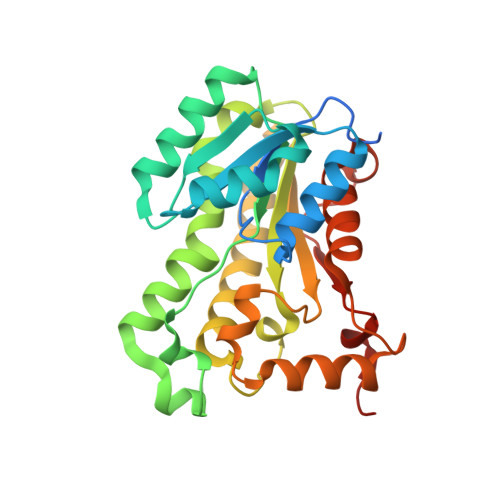Structure of the Francisella tularensis enoyl-acyl carrier protein reductase (FabI) in complex with NAD(+) and triclosan.
Mehboob, S., Truong, K., Santarsiero, B.D., Johnson, M.E.(2010) Acta Crystallogr Sect F Struct Biol Cryst Commun 66: 1436-1440
- PubMed: 21045289
- DOI: https://doi.org/10.1107/S1744309110039862
- Primary Citation of Related Structures:
3NRC - PubMed Abstract:
Enoyl-acyl carrier protein reductase (FabI) catalyzes the last rate-limiting step in the elongation cycle of the fatty-acid biosynthesis pathway and has been validated as a potential antimicrobial drug target in Francisella tularensis. The development of new antibiotic therapies is important both to combat potential drug-resistant bioweapons and to address the broader societal problem of increasing antibiotic resistance among many pathogenic bacteria. The crystal structure of FabI from F. tularensis (FtuFabI) in complex with the inhibitor triclosan and the cofactor NAD(+) has been solved to a resolution of 2.1 Å. Triclosan is known to effectively inhibit FabI from different organisms. Precise characterization of the mode of triclosan binding is required to develop highly specific inhibitors. Comparison of our structure with the previously determined FtuFabI structure (PDB code 2jjy) which is bound to only NAD(+) reveals the conformation of the substrate-binding loop, electron density for which was missing in the earlier structure, and demonstrates a shift in the conformation of the NAD(+) cofactor. This shift in the position of the phosphate groups allows more room in the active site for substrate or inhibitor to bind and be better accommodated. This information will be crucial for virtual screening studies to identify novel scaffolds for development into new active inhibitors.
Organizational Affiliation:
Center for Pharmaceutical Biotechnology, University of Illinois at Chicago, 900 South Ashland Avenue, Chicago, IL 60607, USA. shahila@uic.edu
















